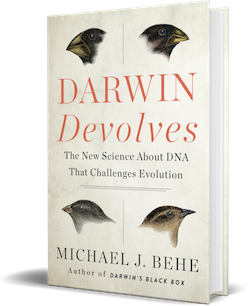 Evolution
Evolution
Puppy Dog Eyes for Darwin


A new study published in the Proceedings of the National Academy of Sciences reports on the canine musculature that underlies “puppy dog eyes.” The study has gotten tons of affectionate press, probably because puppies are so darned cute.

The story is also cast in an evolutionary framework. The researchers found that a particular muscle abbreviated LAOM is almost always present and well-developed in dogs but is often missing or much less well-developed in wolves. The muscle allows dogs to raise their inner eyebrows in a way that humans find attractive. Since dogs are descended from wolves, the change is ipso facto “evolution.” The authors go on to speculate that the trait was selected over time by humans adopting the dogs that seemed cutest.
Well, okay, why not. However, the study is simply a description of dog and wolf anatomy. No studies were done to find the genetic alterations that led to the doggy ability. Thus it tells us pretty much nothing about the evolutionary mechanism. As I discuss in my new book, Darwin Devolves, many studies have shown that the genetic changes leading to the traits of various dog breeds — curly coat, shortened muzzles and legs, and more — are largely degradative. That is, the mutations mostly break or blunt pre-existing genes. For example, one mutation in dogs leads to increased muscle mass; it’s due to “a two-base-pair deletion in the third exon of MSTN leading to a premature stop codon at amino acid 313.” In other words, the increased muscle mass is due to a broken gene.
Puppy dog eyes can melt the hearts of us humans but it’s entirely possible — and quite likely in my view — that the mutation behind the muscle for “puppy dog eyes” is also degradative.
Photo credit: Bharathi Kannan via Unsplash.
